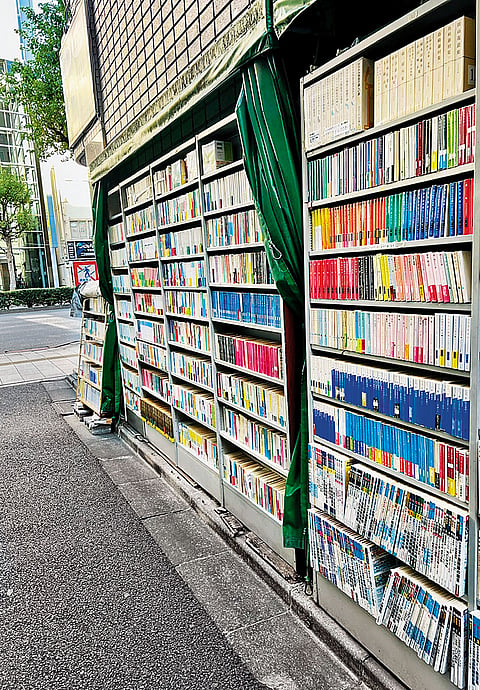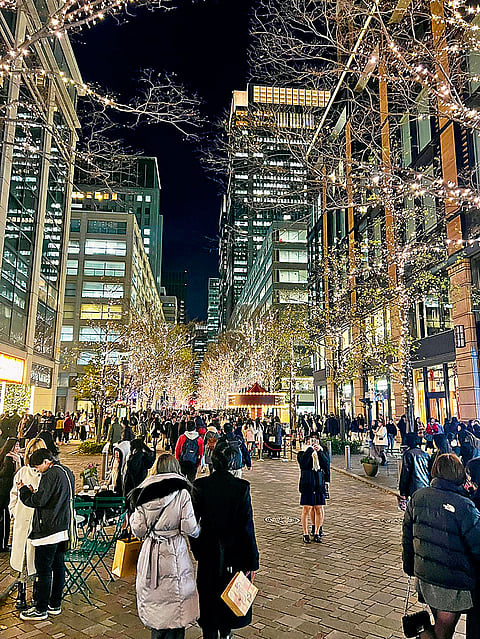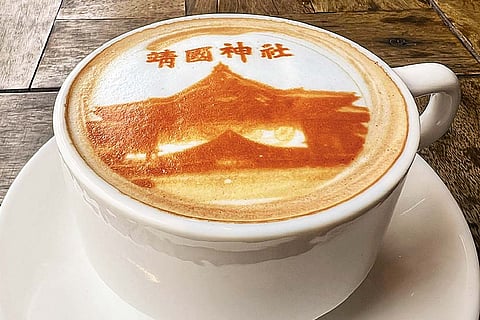You don’t travel to Japan. Japan travels to you.
Golden Lessons In Zen From Travels In Japan
In all of this sprawling expanse of urbanism, I did not once find a bit of litter anywhere in Tōkyō (or elsewhere in Japan). This speaks of a superhuman municipal task force, but equally suggests how much the residents are invested in keeping their country clean and, yes, perfect.
I wrote these lines while waiting to board the flight to Narita, in part anticipation and part intuition. Having aborted a trip to watch the Rugby World Cup in 2019 due to typhoon Hagibis, Japan had remained a quiet reminder at the back of my mind. Now, with a week spent in Japan, I wasn’t far off the mark. Adrenaline is misplaced here. Like their meditative anthem Kimigayo, the vibe (if you can call it that) is serene, even tranquil. Behind the veil of bustling urban life lies the solid bedrock of a civilisation that is deeply reflective. And with it the yūgen or mysterious beauty of a land that merges a delectable aesthetic with extreme efficiency.
First views from the Narita Express are of homes with seemingly Malnad roofs, cubist, art decō apartments and Mount Fuji watching over the city like an observant grandfather. It is unsurprising that Hokusai and other Japanese artists have been so enamoured with this snow-capped mountain for its intriguing presence close to the capital. River Sumida-gawa gracefully meanders through the entrails of the city. My first impression of Tōkyō city centre was of New York minus the chaos. The Tōkyō Station Gallery had an exhibition of Buddhist and Shinko art traditions, while the Artizon Museum close by had a special on Marie Laurencin, titled An Eye For Her Time. Paris has named its modern art museum Palais de Tōkyō, and Tōkyō returns the favour with an elaborate exhibition of French Cubism at the Museum of Western Art, with signs at the Nijō-jō Castle in Kyōtō in French, apart from Japanese and English.

Contrasts are a way of life here. While a waiter was offended when I inadvertently left a tip, the security person at the station gallery most politely bowed and pleaded with visitors not to take photographs. A city which is slick beyond belief, has forests, gardens and shrines in abundance. Shops offer you practically everything you can want, but attendants thank you profusely even when you do not buy. Politeness in Japan is a given. It is like a world made up of gentle kindergarten teachers.
I did not once find a bit of litter anywhere in Japan. This speaks of a superhuman municipal taskforce and suggests how much the residents are invested in keeping their country clean.
And in these contrasts, came the revelation of Kitazawa—easily the finest English bookstore for used and rare books I’ve seen. I spent three hours, missed lunch and spent many yen at this treasure of a bookshop. The ground floor has only Japanese books (many of which are read vertically, and opened right to left). When I asked the attendant if they stocked English books, she sheepishly said, ‘Only for children’, and pointed me to the first floor. Perhaps this was a Zen lesson in the understated? Not far is a street of second-hand Japanese books, displayed in open shelves on the road with no one watching over the stock. Some of the sets were over 60,000 ¥! My schoolmate Rohan-san, whom I met on my trip, tells me how locals use their wallets to hold a table while they step out for a call or to use the washroom. Most train station gates are open and unmanned, but everyone taps their card or buys a ticket anyway. Trust and honour are built into the Japanese DNA. Bushido is the word I am looking for.

The commitment to aesthetics is striking in everyday ways. The latté at the Yasukuni Jinja can be ordered with designs in the froth ranging from cherry-blossom trees to a temple. It seems almost cruel to drink away such beauty! The Yasukuni shrine, dedicated to fallen warriors since the Boshin War of 1868-69, represents a blend of the martial and spiritual alike. (A portrait of Radhabinod Pal celebrates the Indian judge whose dissent vindicated the position of the Japanese in the Tōkyō Trials.) The peace one finds at these shrines is matched at the elegant cemeteries that dot the city. Death is a philosophical reality in conversations here, and the coffin in ceramic at the Tōkyō National Museum is the pièce de résistance.
The Shinkansen is expectedly world class, and with a Japan Rail pass one can traverse the country in a day. Train stations are massive and ecosystems in themselves, buzzing with superb restaurants, shopping arcades and the cleanest toilets you can imagine. One quickly learns that the exit from a station is a matter of navigating a maze of many levels and passages, and can mean a 10-15 minute walk. The love affair with food is a story in itself. It sounds laughable when you hear of guests making bookings at Michelin star restaurants in Japan. Perhaps the finest meals I ate were at small, anonymous outlets at train stations and dingy markets. My best meal of the trip (of buckwheat Soba noodles, soup, Wasabi stem and fried rice) was at the Narita airport terminal. A close second was Naru ramen and a scoop of black bean ice-cream near Onarimon station.
As the aircraft pulled away, the Japanese ground staff stood at the gate and vigorously waved us a beaming goodbye. they continued to do till we were airborne.
The Japanese take their food personally, and cook it and serve it personally too. Some of the most delectable diners are run by single owners, who cook, converse and clean up themselves. At a side lane in bustling Dotonbori in Osaka, I veered into a five-seater a la Netflix’s Midnight Diner: Tōkyō Stories. The chef spoke not a word of English but was prompt in arranging a video call with his wife who translated to him what I wanted to eat! He made sure I was introduced to his little daughter on the call too. For those who mistake tea ceremonies for meditation, Pico Iyer in his masterful writings on Japan, reminds us these ceremonies are premised more on the love to serve. (Post script: the Dotonbori dinner was the most expensive meal I ate on my trip, with no menu or prices. Such are the ways of Japan.) At ‘Antique Coffee Bar’ in mainstream Ginza, you get served cake and tea in the finest bone china, with leather and teakwood to transport you away from the bling outside. Payment in such old-school places is only in cash, and cash is always placed on a small tray and not handed directly to the person behind the counter. Etiquette is everything.
As is industry. The magnificent Seikō Museum in Ginza district hosts calligraphy by its founder Kintaro Hattori that reads ‘Life is Work’. This may rankle with contemporary ideas of work-life balance, but to the Japanese, this is verily the way to be. (Reminds me of my late father who would often say work is worship.) At the museum, you see some of the finest time-pieces known, but also, burnt clocks depicting the loss that fires from earthquakes caused. Loss is acknowledged head on, not in grief but in learning. My visit to the gut-wrenching Hirōshima Peace Museum (with sudden snowfall) showed me how bravely the city has faced up to what was simply hell on earth. One sees no blame or pathos, but only facts and acceptance. Golden lessons in Zen. And in the spirit of contrast, the pilgrimage to the museum can be followed by a stroll through joyful Hondōri—a semi-enclosed market like London’s Burrough Market, where one can find everything from pets to pottery.

Shimokitazawa in Tōkyō is hipster and edgy. The young employees at the Tsutaya bookstore were clueless when I asked them where one could get good Japanese food. Never mind that just outside were lanes of the best Japanese food one could seek. At a diner owned by a Bob Marley fan, the menu was refreshingly vegan—a rarity in Japan. Going on outdoors was a photoshoot with a queer model sitting on the road, near a bookstore named Village Vanguard, ostensibly after New York’s legendary jazz club. At the Marley diner, a customer asked me about my itinerary and then stoically remarked how ‘PC’ it was. Indeed, travelling to the well-known cities as I did is politically correct and a surface view of the richness of Japan. That said, there is nothing conventional or predictable about these cities (while I quickly resolve to return to more remote parts of the land in the years to come).
Alex Kerr’s luminous book Another Kyōtō opens the gates of the historical capital of Japan. Some of these gates stand alone, with no doors or side walls, portraying the mystique of all that is Japanese. The Nijō-jo Castle—a UNESCO World Heritage Site—is a breathtaking masterpiece of design and craftsmanship. Ironically, the souvenir shop sells tacky mementos that do no justice to the monument. No photographs are permitted inside the castle, while glossy postcards are sold for as little as 100 ¥ in the shop. Anime stands proudly besides custom. ‘Change is tradition’, as Stephen Mansfield pithily observes in Tokyo: A Biography.

The walk through the internal rooms at Nijō, where the shoguns exercised power, are striking for both—their minimalism and their aura. For those interested in intricate floors, ceilings and mural art, this is a living catalogue. The gardens adjacent are a delight to walk through, and the tea house is an unmissable experience. Matcha cake with a pot of green tea seated on heated cushions warms the soul in the biting cold of December. Carps in the ponds are so accustomed to visitors feeding them, they raise their heads from the water with mouths open.
Banine, in her racy memoir, Parisian Days, says, ‘Whether you go this way or that, whether you go forwards or back, you’ll still be in Paris.’ This is true of Tōkyō, teeming with 37 million residents in its extended metropolis, yet never really crowded or chaotic (except at peak-hour on the Metro.) The scale of the city hits you from the top deck of the Tōkyō Tower, with skyscrapers as far as the eye can see. Like its cousin, the Eiffel, the tower stands over 300 metres tall. (The Tōkyō Skytree is twice as high!) The hostess in the elevator at the tower times her Japanese and English welcome perfectly to end at the floor where the elevator stops and makes you think AI is unnecessary in Japan.
In all of this sprawling expanse of urbanism, I did not once find a bit of litter anywhere in Tōkyō (or elsewhere in Japan). This speaks of a superhuman municipal taskforce, but equally suggests how much the residents are invested in keeping their country clean and, yes, perfect. One does not see dustbins on the streets and you are expected to carry and clear your own trash. With an AQI of 25, we Delhi folk have a lot to be jealous of. In eight days of travel, I saw just one rough-sleeper, on his knees in a Buddhist pose.

I revelled in watching Kabuki at the acclaimed Kabuki-za in Tōkyō. The elegance of the venue and the dramatic art form with elements of opera, tai chi and dastangoi make this kodan storytelling very special. Again, the theatre shop flattered to deceive. Some of the finest Kabuki block prints are available instead, at the shop at the Tōkyō National Museum or at the airport. At the former, you have a section on the centuries-old noh masks with expressions that make it hard for one to look away.
The engagement with nature is de rigueur. The Imperial Palace at the heart of the business district of Chiyoda in Tōkyō has its own forests and canals. The walking path alongside the palace is to be relished and regularly has runners training for the marathon. The names of the Shinkansen are all chosen thoughtfully—Sakura: cherry-blossom, Harita: ray of light, Kodama: echo. The green lights at traffic signals tweet calls of Japanese birds. At Ueno, which is a wonderous university area, the zoo stands beside the Metropolitan Museum. At the museum you have a collection of adorable portraits of gorillas, life-size replicas of all Japanese birds and, while I was there, a special exhibition on thoroughbreds. The splendid Tōkyō National Museum has gardens annexed to it that one could get lost in.
Kakuzo Okakura in The Book of Tea wistfully observes that one must not have too little or too much tea in them. Japan manages this harmony to perfection. It makes me wonder what the rest of the world has learnt from Japan. Her sports fans clean up stadia after all other spectators have left. Here, flavour and soul meet efficiency and intrigue. The Nihonjinron or the ethos of mystery is for real. But all in all, the energy is pure. This is no ordinary way of life.
I left Tōkyō on Christmas Eve, on an Air India flight delayed by a mere eight hours. As the aircraft pulled away, the Japanese ground staff stood at the gate and vigorously waved us a beaming goodbye. This they continued to do till we were airborne. No strings attached. Just good Japanese spirit that left me with a lump in my throat.
Arigato Gozaimasu, Japan.
(Dedicated to the memory of Darren Mathew Punnen, lawyer and friend, who passed away on December 4, 2023.)
Aditya Sondhi is a Senior Advocate